Grit, trust, and collaboration: Restoring clean water to a community amid drought and a pandemic
In Kenya, 2019 was one of the driest years on record – following the global trend of climate change driving severe weather patterns to the extreme. As a result, we observed increased regional fluctuations in the water table throughout Western Kenya.
Asman Sumba Spring in Eshiakhulo, Kenya was one of the water points most impacted by this trend. Since the spring’s completion, we observed that its water gradually dwindled.
The changes at Asman Sumba Spring limited its yield and slowed community members down as they fetched water, consequently limiting the protected spring’s intended goal to provide reliable and easily accessible water.
Community members shared their frustrations about the spring’s decreasing yield. With each monitoring and evaluation visit, there was no recorded improvement. Our teams assessed if there were any problems with the spring’s construction but they found no indications of a physical failure within the spring’s structure.
“This was making the community suffer and also caused conflict as they had to wait in line so that the container could be filled. They do not have any other water source that supplies safe and clean drinking water,” recalled Team Leader Emmah Nambuye.
Everyone agreed it was time to find a solution to once again improve the Eshiakhulo community’s access to clean, safe, and reliable water from Asman Sumba Spring.
Because of our commitment to people in this community (and the lasting impact that our supporters want to make), we decided to implement a new technology at Asman Sumba Spring: a 1,000-liter reservoir tank.
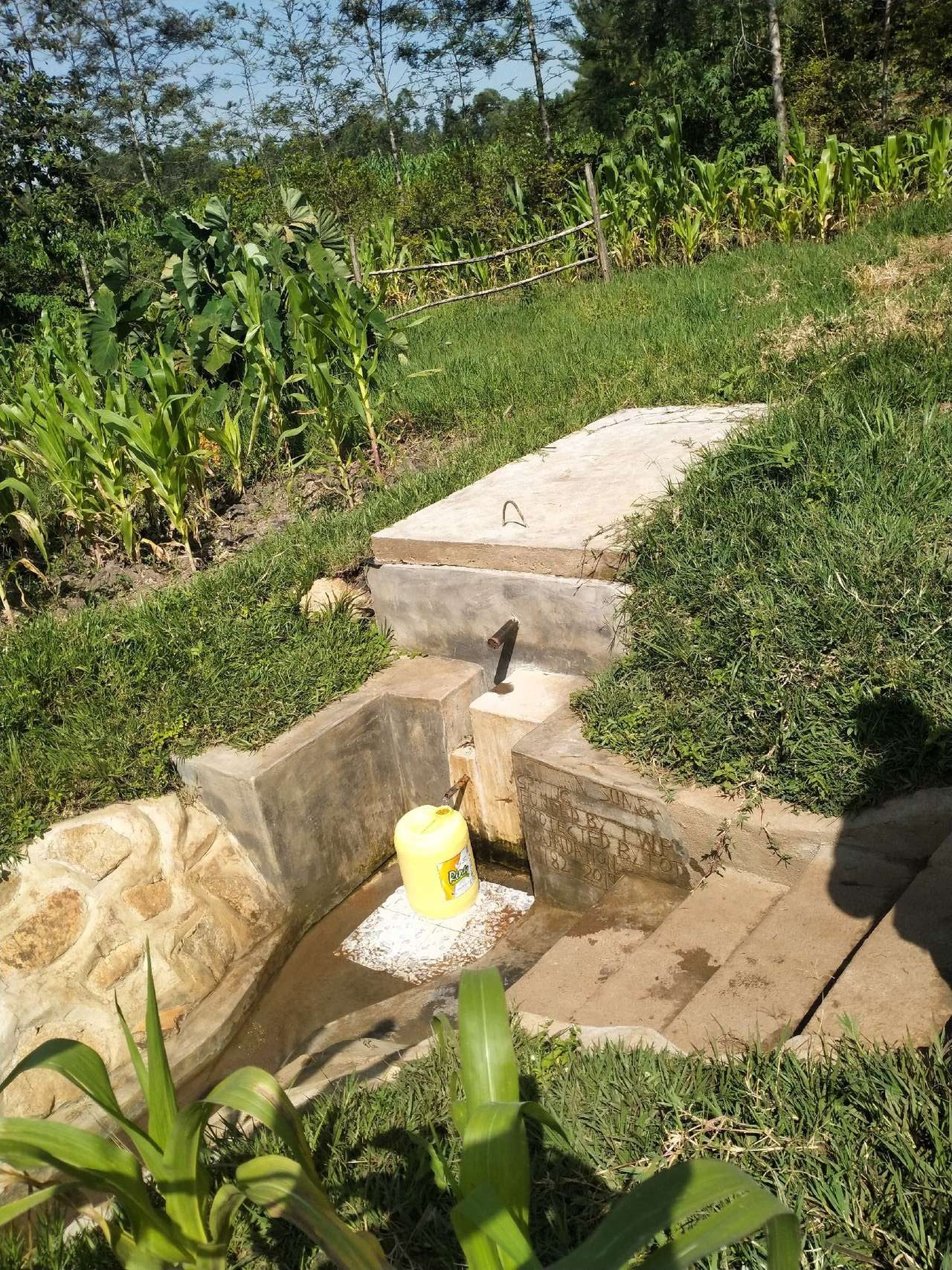
Water flows at Asman Sumba Spring from the recently completed reservoir tank.
The reservoir tank fills overnight and is fitted with a tap to keep the water in place until it is needed come morning. While we expect the seasonal rains to continue to recharge the spring and provide more water, the reservoir tank will enable Eshiakhulo community members to start each morning and evening with a ready water supply.
The reservoir tank will help ensure that the spring remains an accessible and reliable source of water even in seasons when the spring yield is lowest.
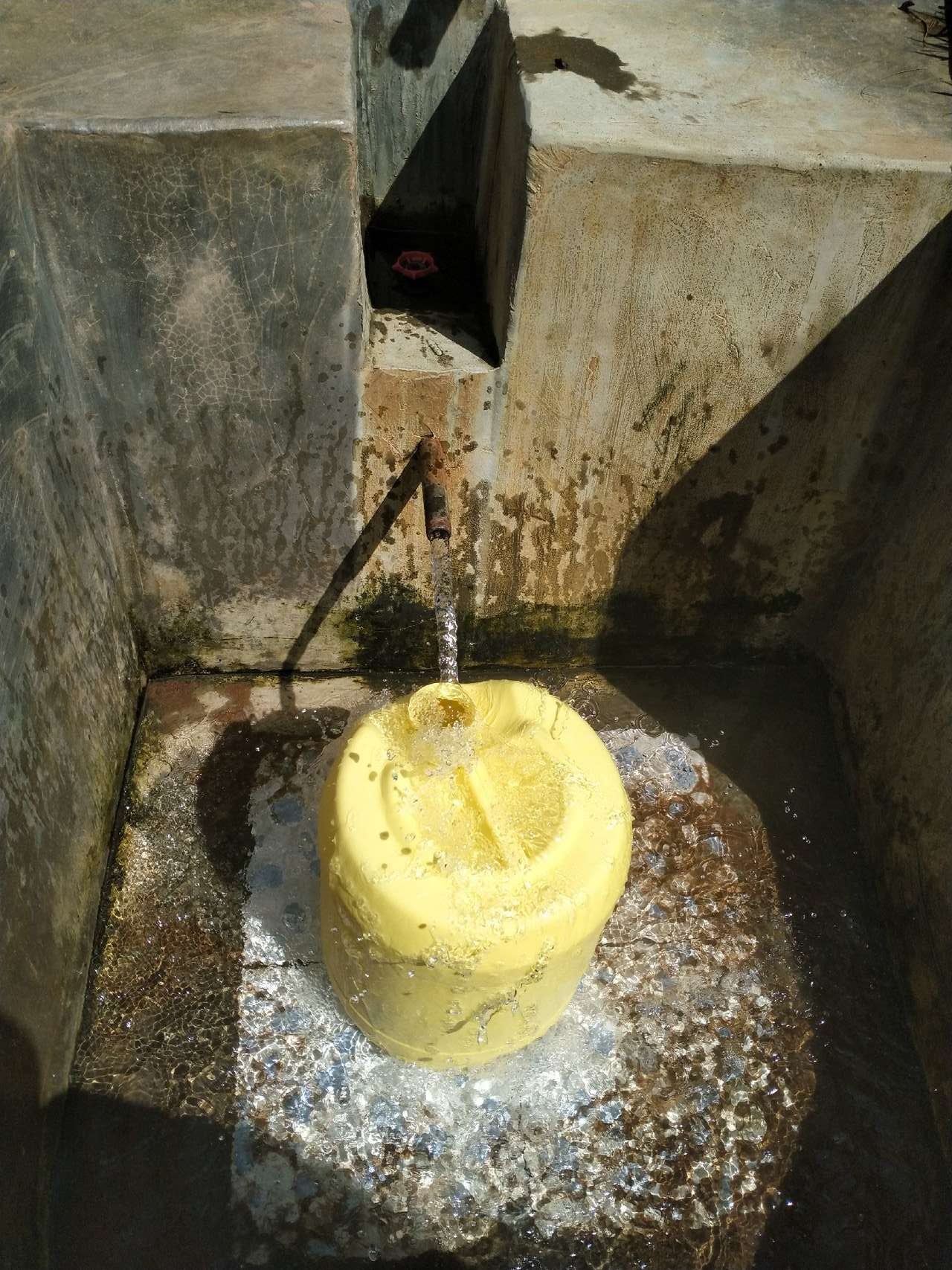
A container overflows with clean water from the Asman Sumba Spring Reservoir Tank.
At The Water Project, we commit to our promise of ensuring safe, reliable water in every community we serve. And this promise doesn’t stop when we finish building a new water point. We continually monitor all of our water points to ensure their function and quality.
Our continuous engagement with the communities we serve is, in part, why our teams have been so well-positioned to reach more than 71,000 people with our COVID-19 prevention trainings since the start of the pandemic. Community members recognize our team members’ faces, they greet them by name, and they trust the information they share.
Furthermore, national governments recognize our teams’ expertise in water access, sanitation, and hygiene. That is why in Kenya, for example, the Ministry of Health designated our teams as essential workers to help deliver the information and skills people need to help fight the coronavirus.
This trust does not come overnight. It grows after years of continuing to show up for communities not just when we are needed most, but each time a conversation, adjustment, or even celebration is in order.
So we continue to answer the pandemic’s challenges just as we would any other challenge our communities face: with determination, decisions based on data and research, and approaches that meet each community’s unique needs.
This unique combination of engagement, trust, and joint problem solving is what led one of our teams to the exciting and new development at Asman Sumba Spring.
Finding Unity in Water Access During the Pandemic
Before we began any new construction, we worked closely with water users to explain the reservoir tank’s intended process and goal. Once the community reached a consensus on the new technology, we asked them to deliver the locally available construction materials to the spring site.
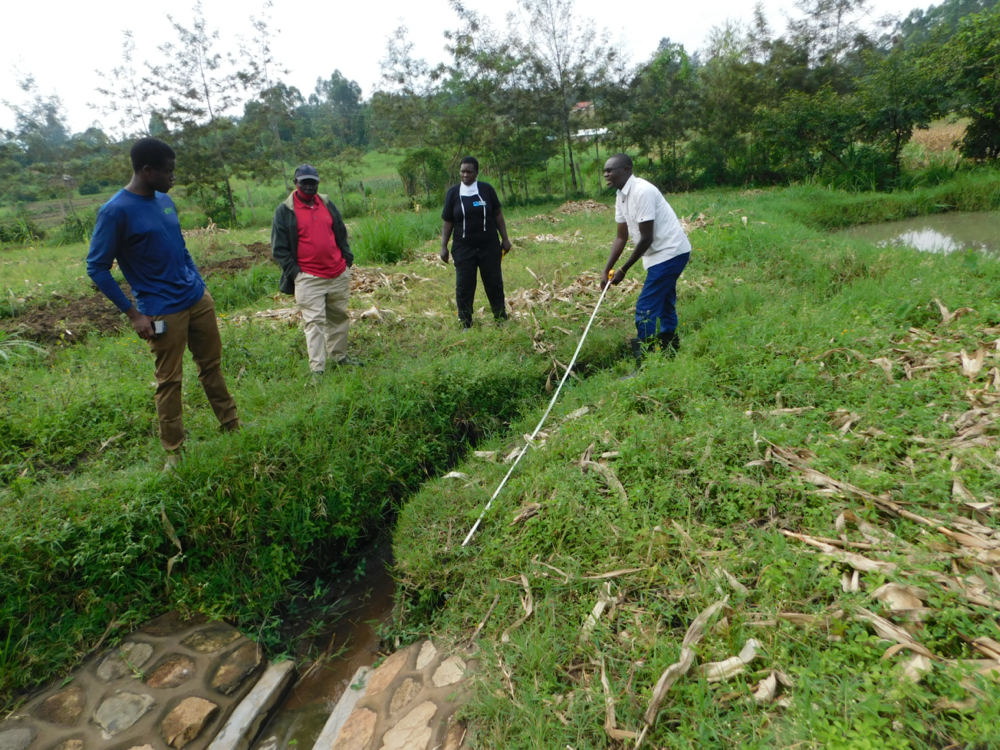
Area Team Leader Emmah Nambuye (second from right) and Regional Director Humphrey Buradi (right) met with community members over several weeks to explain the proposed reservoir tank and show where its new measurements would fall.
These materials included bricks, sand, large rocks, and smaller stones. Some community members would have to break down stones by hand to create gravel. Also, certain homes would need to volunteer to cook food for the artisan and the work team, while others would volunteer their time as day laborers to assist the artisan. Our team would provide the concrete, hardware, and an expert artisan to lead the construction in exchange.
But collecting the materials presented a new problem within the community.
“The major challenge that had caused the delay is that the Eshiakhulo community never had time to sit together and collect the required materials for the reservoir tank construction,” Emmah said.
“The majority of able-bodied community members are working outside the county, and they rarely come home, except during long holidays like December. The Water User Committee leadership had tried all ways but had nearly given up.”
Then, in April, something shifted.
“During our sensitization training on COVID-19, we noticed that the number of the community members had increased, and we could see new faces around because the pandemic had caused them to come back home as most jobs closed doors. We seized the opportunity and urged the Water User Committee Chairperson, Mr. Juma, to talk to the new members on the need for the reservoir tank.”

At a COVID-19 sensitization training in April, our team noticed more and different community members in attendance than those who typically came.
“Amazingly, they quickly agreed, and when the rest of the water users saw that sand and bricks had been donated (which were a challenge to them as it cost money), they came together and gathered the rest of the materials like hardcore (large stones) and ballast (gravel).”
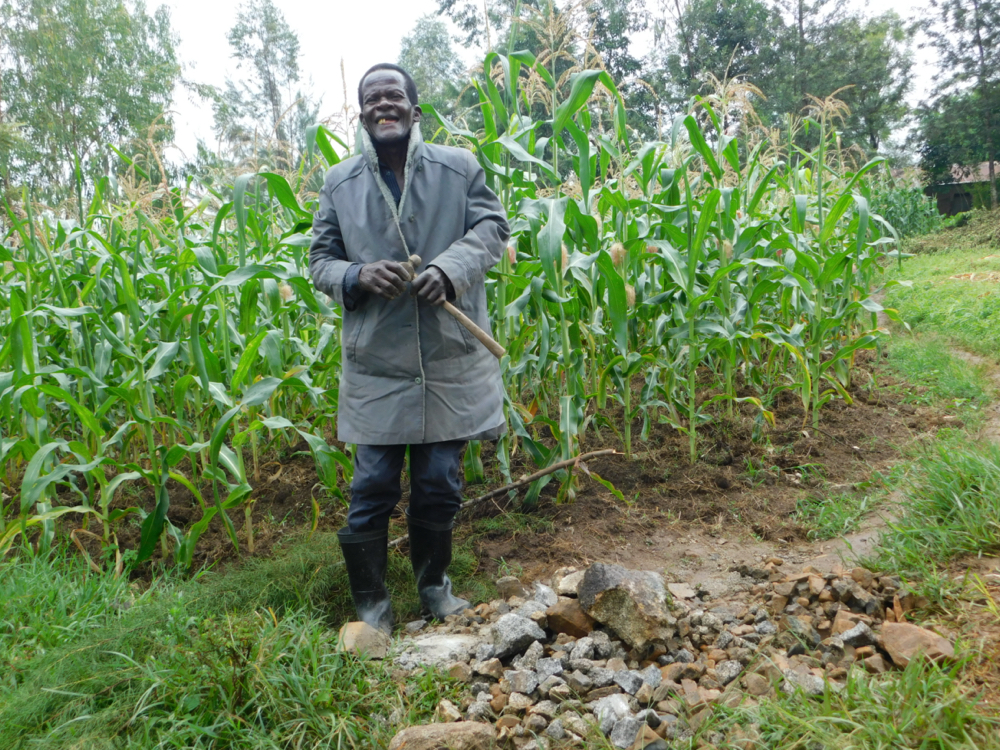
This community member donated the bricks needed for the reservoir tank.
“Within five days, all the local materials had been gathered at the spring, and the community was waiting for our hardware materials and artisan to commence work. During the construction, the artisan had an easy time since everyone offered to help, and the work went on rather quickly.”
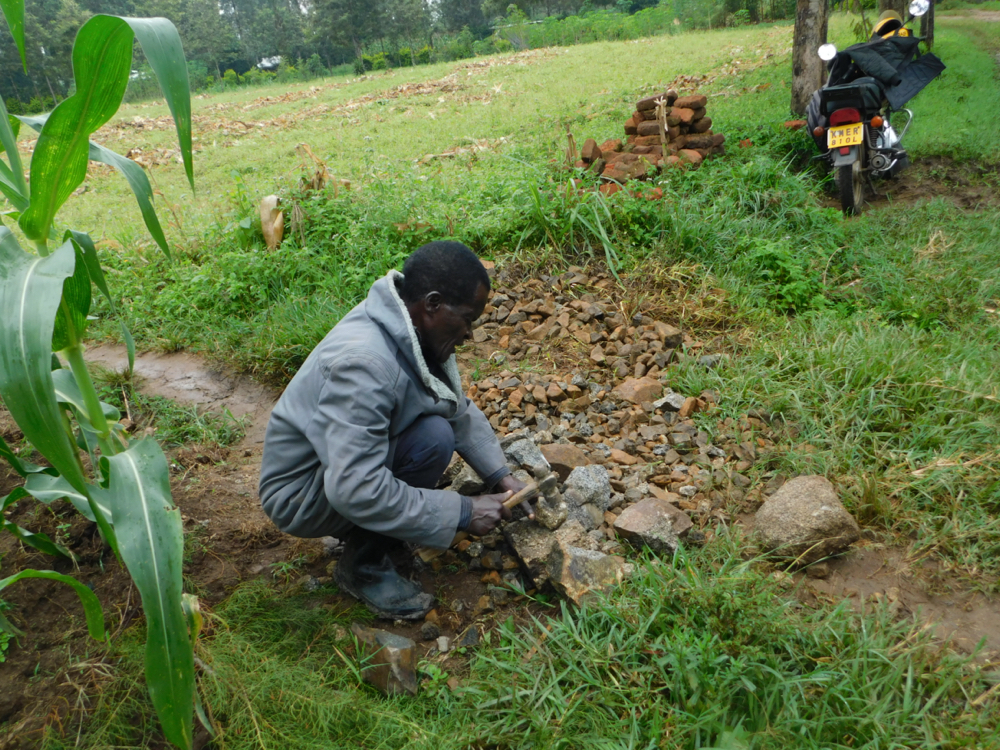
Breaking stones into gravel.
“For us, we are happy that COVID-19 helped the community to come together to get a reservoir tank, and now the discharge speed is 32 seconds. It has also unified the community, and conflicts are a past thing. Now the functionality of Asman Sumba is great, and everybody is happy!”
From Standard Spring to Reservoir Tank: A Step-By-Step Construction Process
When all of the materials were finally ready, we arrived in Eshiakhulo and began work.
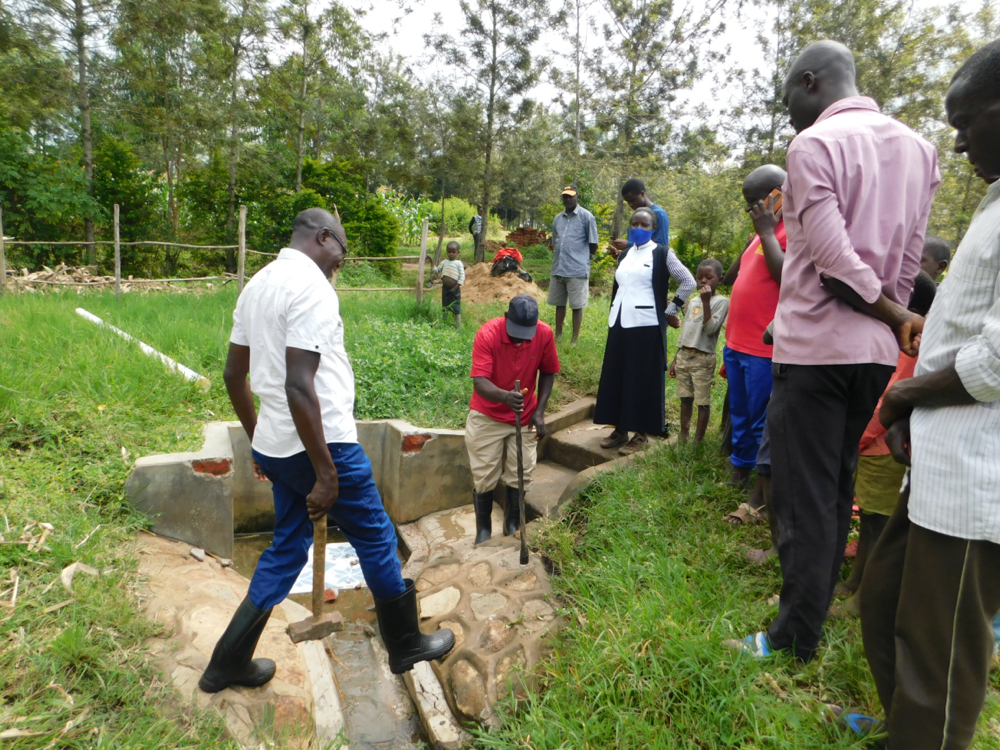
The reservoir tank groundbreaking ceremony marked a turning point in unity and water access for Eshiakhulo community members.
The reservoir tank construction process is very similar to the spring’s original construction. First, it was all hands on deck to excavate the site. We began by removing most of the existing spring structure’s external parts, including the stone pitching, cement drainage channel, and stairs. We also deepened and widened the spring’s drainage channel to create room for the new collection point, as the original spot becomes the site of the reservoir tank.
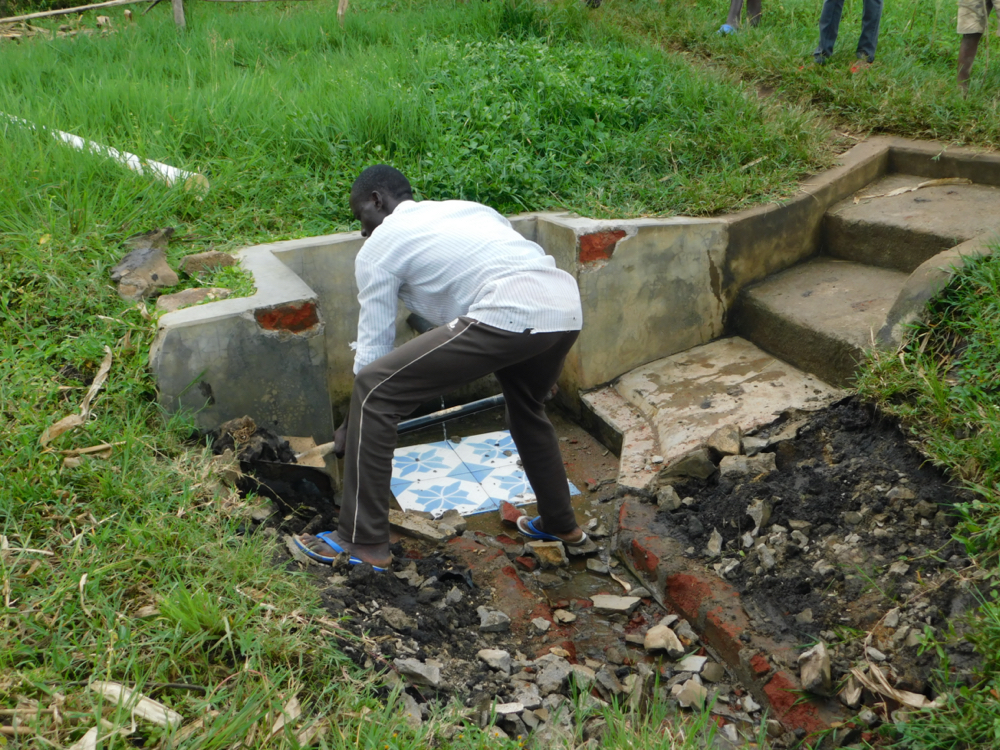
Demolition of the spring’s original rub walls, access area, and stairs.
To allow continued water access during construction and to avoid washing away the new work, we diverted the spring water for several days. We do this by either redirecting the water to the underground escape channels dug during the spring’s initial construction or using a long PVC pipe to connect to the discharge pipe and angle away from the work area.
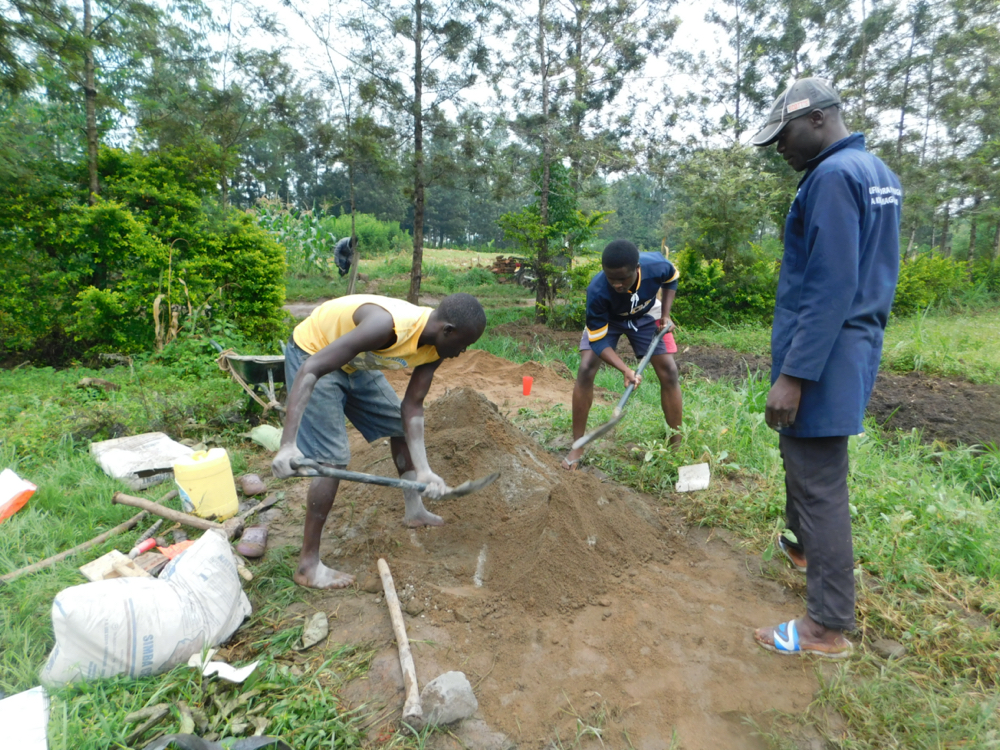
Community members help mix materials for the artisan’s use.
Some of the few fundamental spring structures we keep intact are the headwall and wing walls. Initially forming the outermost walls of the spring’s access point, we turn these features into the reservoir tank’s interior back walls. In front of the headwall, we measure 1 meter wide by 1 meter high by 7.5 meters long to form the new tank.
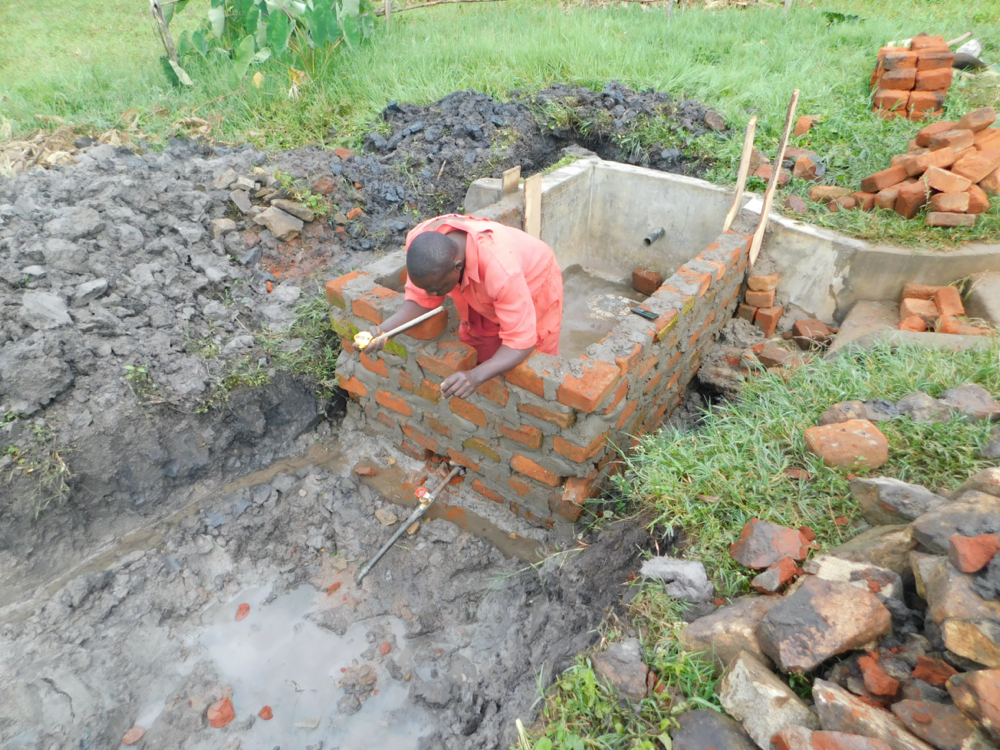
Artisan Joseph at work on the reservoir tank’s brick walls and gate valve.
Inside these measurements, we pour the tank’s concrete foundation using a mixture of cement, sand, gravel, and waterproof cement together with a mesh wire reinforcement. We then begin brickwork to join the new foundation to the headwall until the tank is 1 meter high. We fit the newly formed wall opposite the original headwall with a gate valve and an overflow pipe at 0.5-meter and 0.9-meter height, respectively.

Laying the new access area’s foundation.
The gate valve is what community members will use to access water, similar to turning on a faucet at a sink. The overflow pipe serves to release water beyond the tank’s capacity, preventing cracks and damage from too much pressure building up inside the tank.
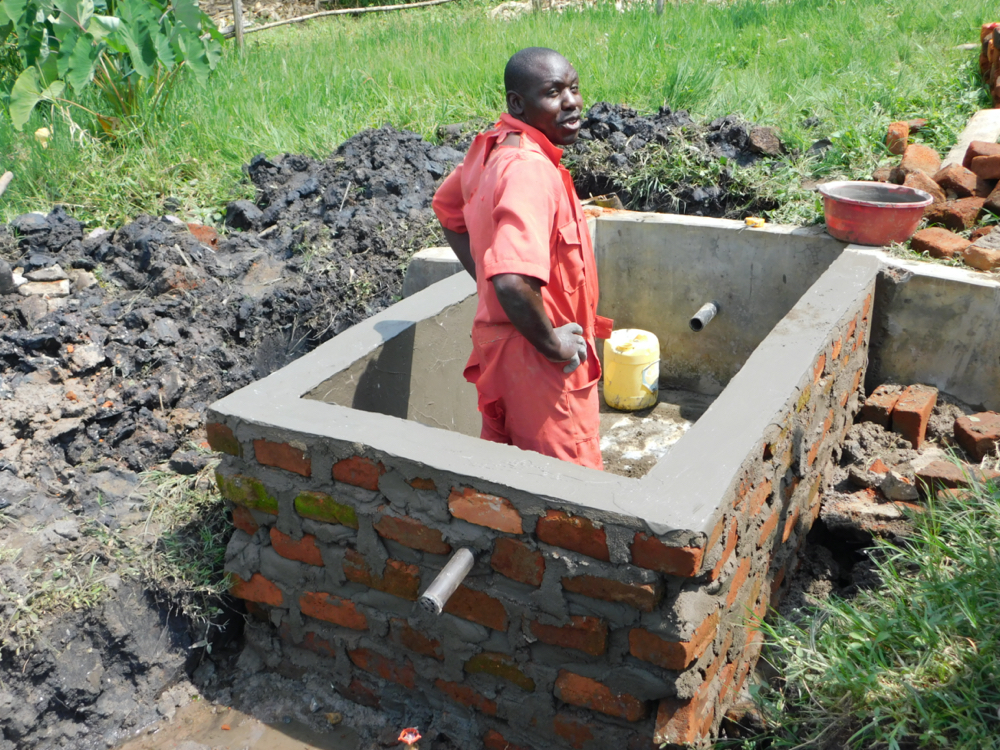
Joseph plasters the reservoir tank’s interior.
Next, we plaster the tank both internally and externally, to create a smooth finish. Upon completing the plasterwork, we wait one day for the tank walls to cure.
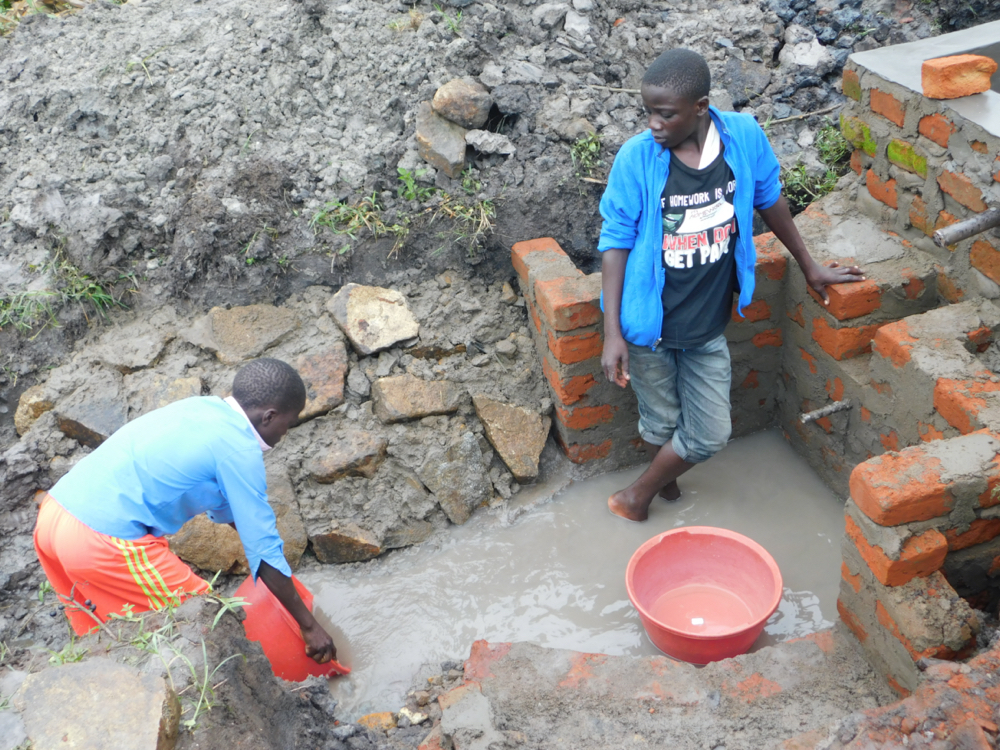
Home from school due to Kenya’s national coronavirus-related school closures, children came wanting to help the artisan each day, too. Here, they help remove water from the new access area under construction.
Once the reservoir tank walls are complete, we move on to one of the tank’s most important features: its cover or top slab. First, we lay reinforcement steel across the reservoir tank walls, followed by iron sheets and a layer of the same concrete mixture used to create the tank’s foundation.
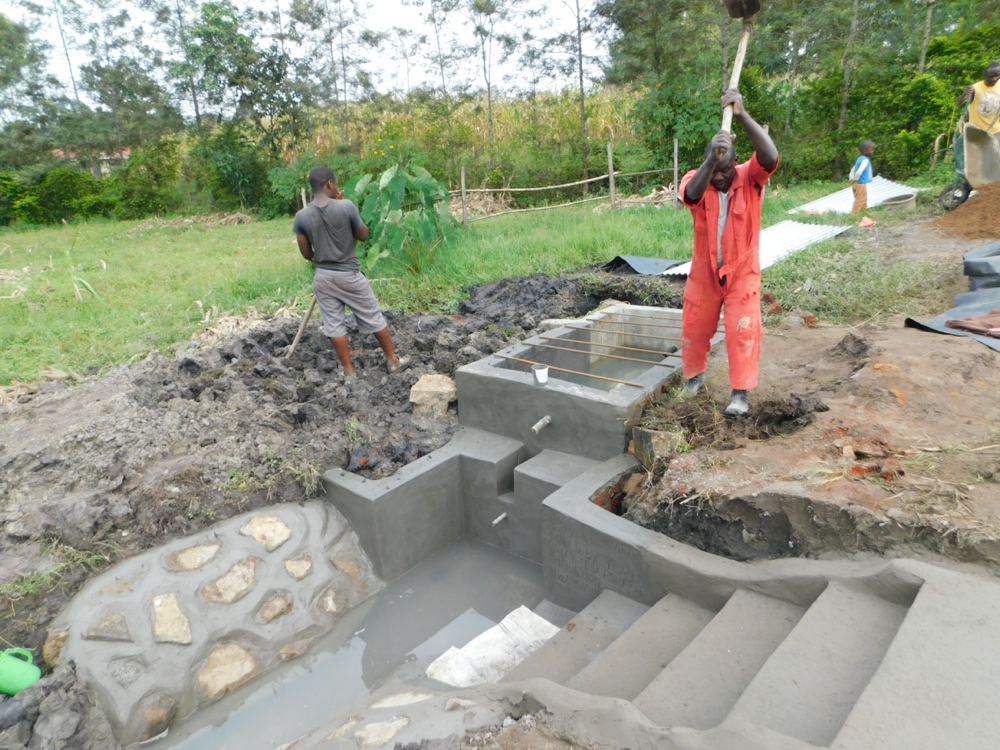
Leveling the ground around the new reservoir tank, which sits ready for a top slab with steel bars laid first.
This slab must be executed with precision; otherwise, weak points could lead to cracks and consequent contamination of the spring water beneath it. The top slab is then sealed to the tank walls with a unique type of mortar that can be removed for any future need to access the tank’s interior without having to break the slab.
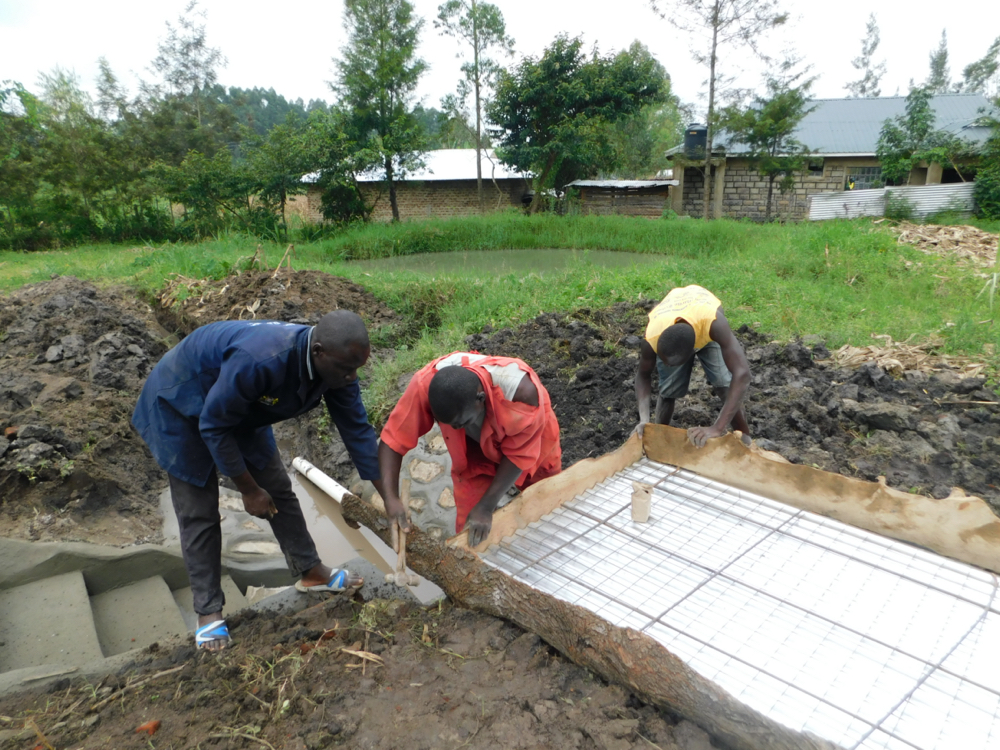
Fitting the metal and wire over the steel bars for the top slab.
Nearing completion, we create a new drawing point in front of the gate valve. We place four new tiles on the floor to maintain the water point’s beauty and help protect the cement from the water’s erosive force. We rebuild the cement drainage channel and its surrounding stone pitching on either side of the new collection point.
Finally, we construct a staircase next to the tank, connecting community members’ original path to the spring with the new collection area. The stairs enhance easy entry and exit from the spring after drawing water.
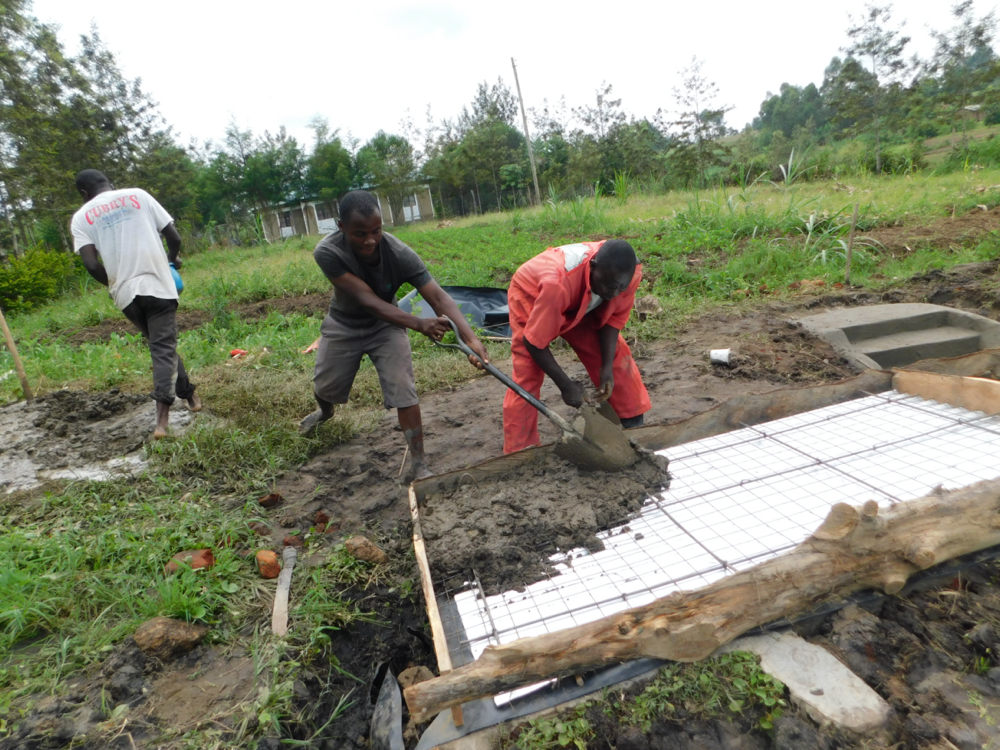
Pouring the top slab’s concrete.
The reservoir tank takes two days to set and cure before allowing the spring water to flow through it for use. Finally, after much anticipation, the reservoir tank is ready for use!
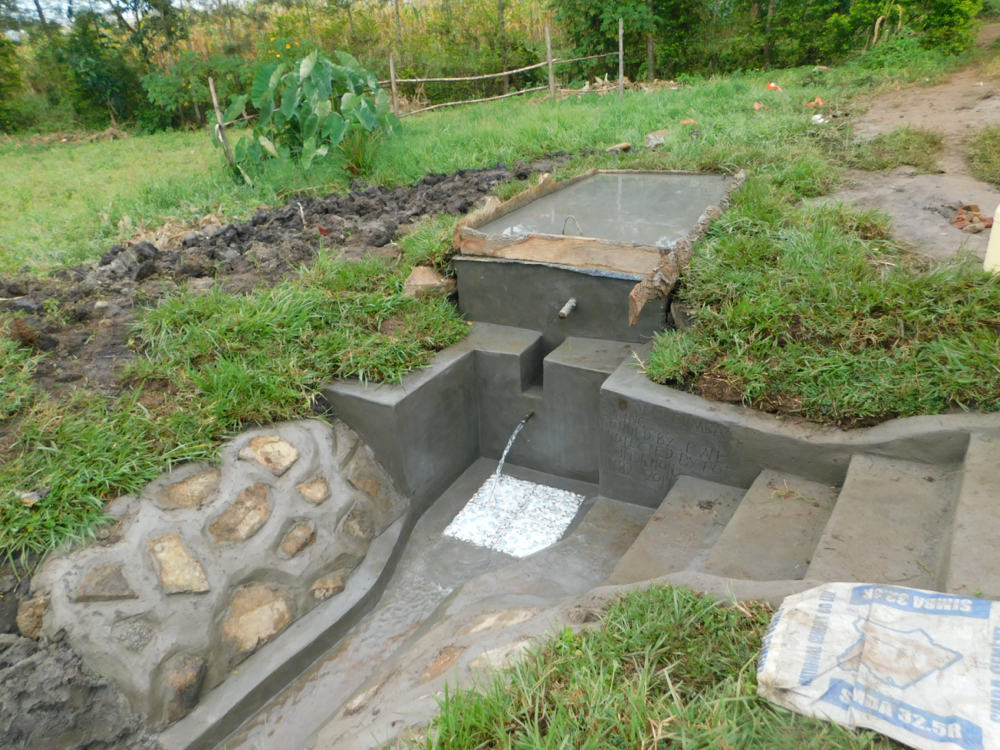
Completed reservoir tank at Asman Sumba Spring.
Community members were thrilled to see the spring’s newly improved discharge rate of 32 seconds. As always, we will continue to monitor Asman Sumba Spring just as we did before the reservoir tank. For now, we celebrate this new milestone in Eshiakhulo community members’ access to safe, clean, and reliable water.
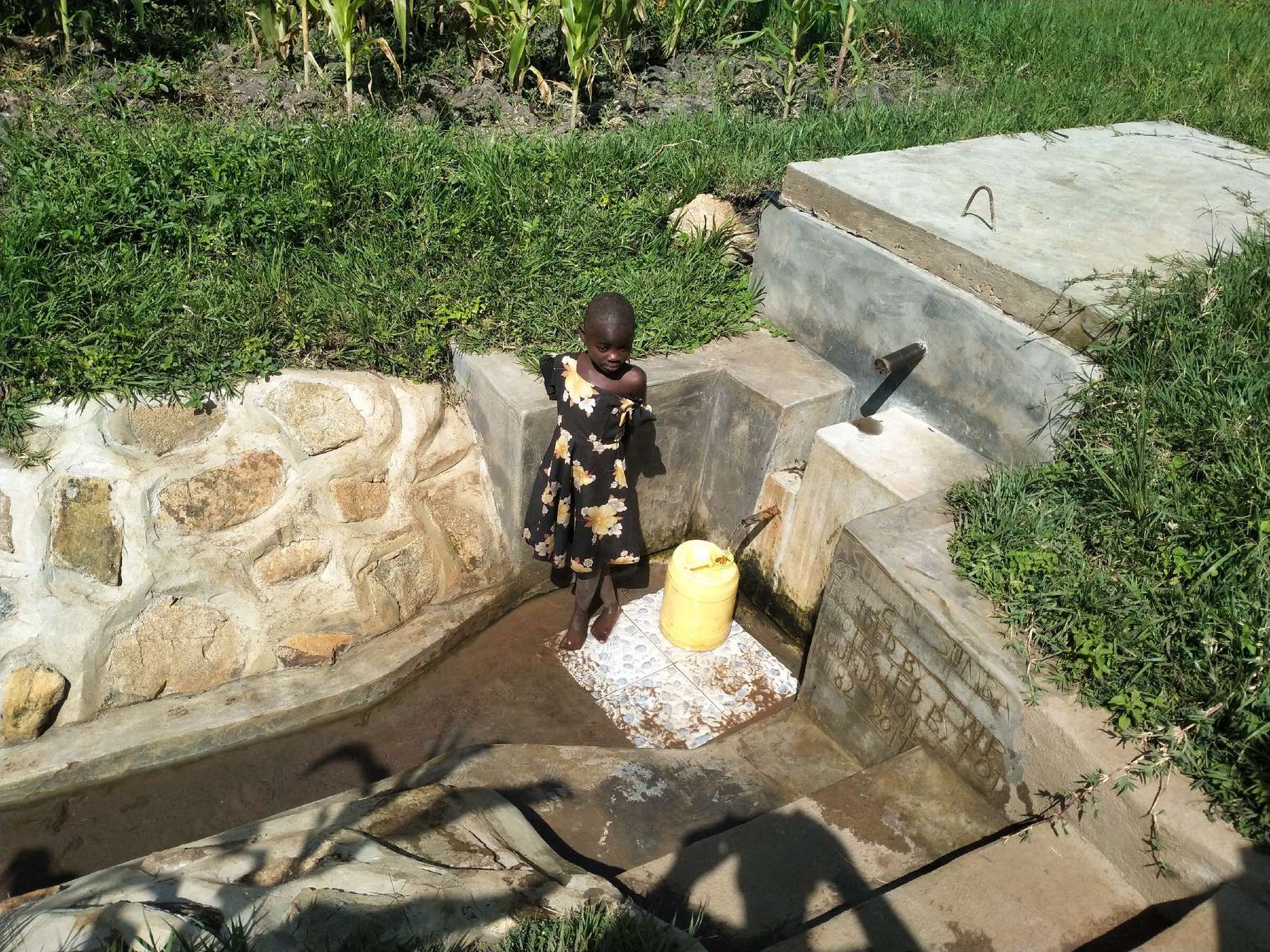
A girl fetches water from the reservoir tank in October.
Tweet